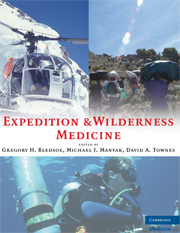Book contents
- Frontmatter
- Contents
- Contributors
- Foreword
- Preface
- Acknowledgments
- PART I EXPEDITION PLANNING
- PART II EXPEDITIONS IN UNIQUE ENVIRONMENTS
- PART III ILLNESS AND INJURIES ON EXPEDITIONS
- 24 General Medical
- 25 The Diarrhea of Travelers
- 26 Malaria: Diagnosis, Prevention, and Treatment for the Traveler
- 27 Wild Animal Attacks and Injuries
- 28 Snake and Arthropod Envenoming
- 29 Hazardous Marine Life
- 30 Expedition Toxicology
- 31 Environmental Injuries
- 32 Penetrating and Explosive Wounds
- 33 Drowning and Submersion Injury
- 34 Evaluation and Acute Resuscitation of the Trauma Patient
- 35 Principles and Practice of Expedition Wound Management
- 36 Expedition Eye Injuries and Disorders
- 37 Dental Medicine on Expedition
- 38 Foot Injuries
- 39 Expedition Orthopedics
- 40 Expedition Self-Rescue and Evacuation
- 41 Aeromedical Evacuations
- APPENDIX The Expedition Medical Kit
- Index
33 - Drowning and Submersion Injury
from PART III - ILLNESS AND INJURIES ON EXPEDITIONS
Published online by Cambridge University Press: 05 March 2013
- Frontmatter
- Contents
- Contributors
- Foreword
- Preface
- Acknowledgments
- PART I EXPEDITION PLANNING
- PART II EXPEDITIONS IN UNIQUE ENVIRONMENTS
- PART III ILLNESS AND INJURIES ON EXPEDITIONS
- 24 General Medical
- 25 The Diarrhea of Travelers
- 26 Malaria: Diagnosis, Prevention, and Treatment for the Traveler
- 27 Wild Animal Attacks and Injuries
- 28 Snake and Arthropod Envenoming
- 29 Hazardous Marine Life
- 30 Expedition Toxicology
- 31 Environmental Injuries
- 32 Penetrating and Explosive Wounds
- 33 Drowning and Submersion Injury
- 34 Evaluation and Acute Resuscitation of the Trauma Patient
- 35 Principles and Practice of Expedition Wound Management
- 36 Expedition Eye Injuries and Disorders
- 37 Dental Medicine on Expedition
- 38 Foot Injuries
- 39 Expedition Orthopedics
- 40 Expedition Self-Rescue and Evacuation
- 41 Aeromedical Evacuations
- APPENDIX The Expedition Medical Kit
- Index
Summary
Drowning and submersion injury are environmental threats that may plague just about any expedition. Environments where this type of injury is a ubiquitous threat include kayaking, sailing, white-water rafting, scuba diving, and, of course, swimming. The threat, however, exists in many places where submersion would seem unlikely such as the desert where flash thunderstorms can rapidly turn dry narrow canyons into raging torrents or alpine environments where a thin snowpack may overlie a glacial runoff river. Urban/suburban environments also offer ample opportunity for drowning and submersion injury. Culverts, drainage canals and ponds, and backyard swimming pools of all sizes pose a threat to young and old alike.
INJURY PREVENTION
Prevention is the central issue in drowning and submersion injury. As will be discussed, treatment of these injuries after the fact has variable effectiveness, which is greatly exceeded in its success by close attention to preparation and safety measures prior to embarking on a trip or going anywhere near the water. Up to 80% of all drowning events are thought to be preventable.
Anyone planning on going into or near an aquatic environment should have adequate swimming skills and be physically fit. A basic knowledge of self-rescue techniques including improvisation of personal flotation devices (PFD) and cardiopulmonary resuscitation (CPR) is imperative. Courses in both are available through several organizations, especially the American Red Cross. Anyone who lacks adequate swimming skills should either reconsider the activity or certainly wear a U.S. Coast Guard–approved PFD during the entire time he or she is on or near the water.
- Type
- Chapter
- Information
- Expedition and Wilderness Medicine , pp. 515 - 528Publisher: Cambridge University PressPrint publication year: 2008



